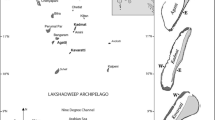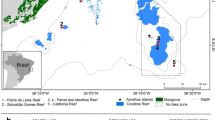Abstract
The reefs of Guam, a high island in the Western Pacific, were impacted by an unprecedented succession of extreme environmental events beginning in 2013. Elevated SSTs induced severe island-wide bleaching in 2013, 2014, 2016, and 2017. Additionally, a major ENSO event triggered extreme low tides beginning in 2014 and extending through 2015, causing additional coral mortality from subaerial exposure on shallow reef flat platforms. Here, we present the results of preliminary analyses of environmental and biological data collected during each of these events. Accumulated heat stress in 2013 was the highest since satellite measurements began, but this record was exceeded in 2017. Overall, live coral cover declined by 37% at shallow reef flat sites along the western coast, and by 34% at shallow seaward slope sites around the island. Staghorn Acropora communities lost an estimated 36% live coral cover by 2017. Shallow seaward slope communities along the eastern windward coast were particularly devastated, with an estimated 60% of live coral cover lost between 2013 and 2017. Preliminary evidence suggests that some coral species are at high risk of extirpation from Guam’s waters. In light of predictions of the near-future onset of severe annual bleaching, and the possibility that the events of 2013–2017 may signal the early arrival of these conditions, the persistence of Guam’s current reef assemblages is in question. Here, we present detailed documentation of ongoing changes to community structure and the status of vulnerable reef taxa, as well as a critical assessment of our response protocol, which evolved annually as bleaching events unfolded. Such documentation and analysis are critical to formulating effective management strategies for the conservation of remaining reef diversity and function.







Photo credits: D. Burdick, W. Hoot, L. Raymundo
Similar content being viewed by others
References
Birkeland CE, Green A, Fenner D, Squair C, Dahl AL (2013a) Substratum stability and coral reef resilience: Insights from 90 years of disturbances to reefs in American Samoa. Micronesia 11:1–15
Birkeland CE, Craig P, Davis G, Edward A, Golbuu Y, Higgins J, Gutierrez J, Idechong N, Maragos J, Miller K, Paulay G, Richmond R, Tafileichig A, Turgeon D (2000) In: Wilkinson C (ed) Status of the coral reefs of the world: 2000. Australian Institute of Marine Science, Cape Ferguson. Pp. 199–217
Birkeland C, Miller MW, Piniak GA, Eakin CM, Weijerman M, Elhany PM, Dunlap M, Brainard RE (2013b) Safety in numbers? Abundance may not safeguard corals from increasing carbon dioxide. Bioscience 63:967–974
Brainard RE, Asher J, Blyth-Skyrme V, Coccagna EF, Dennis K, Donovan MK, Gove JM, Kenyon J, Looney EE, Miller JE, Timmers MA, Vargas-Angel B, Vroom PS, Vetter O, Zgliczynski B, Acoba T, DesRochers A, Dunlap MJ, Franklin EC, Fisher-Pool PI, Braun CL, Richards BL, Schopmeyer SA, Schroeder RE, Toperoff A, Weijerman M, Williams I, Withal RD (2012) Coral reef ecosystem monitoring report of the Mariana Archipelago: 2003–2007. Pacific Islands Fisheries Science Center Special Publication SP-12-01, 1019 pp
Bruno J, Siddon C, Whitman J, Colin P, Toscano M (2001) El Niño related coral bleaching in Palau, Western Caroline Islands. Coral Reefs 20(2):127–136
Burdick D, Brown V, Asher J, Caballes C, Gawel M, Goldman L, Hall A, Kenyon J, Leberer T, Lundbald E, McIlwain J, Miller J, Minton D, Nadon M, Pioppi N, Raymundo L, Richards B, Schroeder R, Schupp P, Smith E, Zgliczynski B (2008) Status of the coral reef ecosystems of Guam. Bureau of Statistics and Plans, Guam Coastal Management Program. iv + 76 pp
Caballes CF (2009) The Role of Chemical Signals on the feeding Behavior of the Crown-of-Thorns Seastar, Acanthaster planci (Linnaeus, 1758). M.Sc. Thesis. 164 pp
Chesher RH (1969) Destruction of the Pacific corals by the sea star Acanthaster planci. Science 165:280–283
Colgan MW (1987) Coral reef recovery on Guam (Micronesia) after catastrophic predation by Acanthaster planci. Ecology 68(6):1592–1605
Cybulski J (2016) Push-core Sampling in Micronesia: Using Paleoecological Data to Reconstruct Guam’s Coral Reef Community. M.S. Thesis, American University. 90 pp
Derrick B, Russ B, Toher D, White P (2017) Test statistics for the comparison of means for two samples which include both paired observations and independent observations. Journal of Modern Applied Statistical Methods 16(1):137–157
Diaz-Pulido G, McCook LJ, Dove S, Berkelmans R, Roff G, Kline DI, Weeks S, Evans RD, Williamson DH, Hoegh-Guldberg O (2009) Doom and Boom on a Resilient Reef: climate change, algal overgrowth and coral recovery. PLoS One 4(4):e5239. https://doi.org/10.1371/journal.pone.0005239
Donner SD (2009) Coping with commitment: Project thermal stress on coral reefs under different future scenarios. PLoS One 4(6):e5712. https://doi.org/10.1371/journal.pone.0005712
Donner SD, Skirving WJ, Little CM, Oppenheimer M, Hoegh-Gulberg O (2005) Global assessment of coral bleaching and required rates of adaptation under climate change. Glob Chang Biol 11:2251–2265
Ferrario F, Beck MW, Storlazzi CD, Micheli F, Shepard CC, Airoldi L (2014) The effectiveness of coral reefs for coastal hazard risk reduction and adaptation. Nat Commun 5:3794. https://doi.org/10.1038/ncomms4794
Fifer J (2018) Examining Gene Expression of Heat-Stressed Staghorn Coral Under Different Flow Environments. Graduate Program in Biology, University of Guam. M.S. Thesis. 144 pp
Hoot WC, Burdick D (2017) Guam Coral Bleaching Response Plan. Bureau of Statistics and Plans. 56 pp
Jokiel PL, Rogers KS, Brown EK, Kenyon JC, Aeby G, Smith WR, Ferrell F (2015) Comparison of methods used to estimate coral cover in the Hawaiian Islands. PeerJ 3:e954. https://doi.org/10.7717/peerj.954
Kendall MS, Poti M (2015) Transport pathways of marine larvae around the Mariana Archipelago. Tech. Memorandum NOS NCCOS 193. 130 pp
MacNeil MA, Graham NAJ, Cinner JE, Wilson SK, Williams ID, Maina J, Newman S, Friedlander AM, Jupiter S, Polunin NVC, McClanahan TR (2015) Recovery potential of the world’s coral reef fishes. Nature 520:341–344
McClanahan T, Baird AH, Marshall PA, Toscano MA (2004) Comparing bleaching and mortality responses of hard corals between southern Kenya and the Great Barrier Reef, Australia. Mar. Pollut. Bull. 48:327–335
Nakamura T, van Woesik R (2001) Water-flow rates and passive diffusion partially explain differential survival of corals during the 1998 bleaching event. Mar Ecol Prog Ser 212:301–304
NOAA Coral Reef Watch (2017) updated daily. NOAA Coral Reef Watch Version 3.0 Daily Global 5-km Satellite Virtual Station Time Series Data for Guam, Jan 01, 2013-March 30, 2018. College Park, Maryland, http://coralreefwatch.noaagov/vs/index.phpf. Accessed 27 Sep 2018
NOAA Center for Operational Oceanographic Products and Services (2013) updated daily. Daily sea level and temperature data at the Apra Harbor, Guam Station ID: 1630000. https://tidesandcurrents.noaa.gov/stationhome.html?id=163000. Accessed 05 Oct 2018
NOAA National Data Buoy Center (2018a) Historical Data for Station 52200—Ipan, Guam. 2013-2017. https://www.ndbc.noaa.gov/station_history.php?station=52200. Accessed 05 Oct 2018
NOAA National Data Buoy Center (2018b) Historical Data for Station 52202—Ritidian, Guam. 2013-2017. https://www.ndbc.noaa.gov/station_history.php?station=52200. Accessed 05 Oct 2018
NOAA Office for Coastal Management (2019) Digital Coast Historical Hurricane Tracks Viewer. https://coast.noaa.gov/hurricanes/. Accessed 28 Apr 2019
PacIOOS (2018) Water Temperature Buoy Observations for Guam. www.pacioos.hawaii.edu/water-category/buoy
Paulay G, Benayahu Y (1999) Patterns and consequences of coral bleaching in Micronesia (Majuro and Guam) in 1992–1994. Micronesica 31:109–124
Randall RH (2003) An annotated checklist of hydrozoan and scleractinian corals collected from Guam and other Mariana Islands. Micronesica 35–36:121–137
Randall RH, Holloman J (1974) Coastal Survey of Guam. UOGML Tech. Rep. No. 14. 404 pp
Raymundo LJ, Maypa AP, Gomez EDD, Cadiz P (2007) Can dynamite-blasted reefs recover? A novel, low-tech approach to stimulating natural recovery in fish and coral populations. Mar Pollut Bull 54:1009–1019
Raymundo LJ, Burdick D, Lapacek VA, Miller R, Brown V (2017) Anomalous temperatures and extreme tides: Guam staghorn Acropora succumb to a double threat. Mar Ecol Prog Ser 564:47–55
Reynolds T (2016) Environmental Regimes Predict the Spatial Distribution of Coral Assemblages and Climate-Induced Bleaching Patterns Around Guam. Graduate Program in Biology, University of Guam. M.S. Thesis. 68 pp
Richmond RH, Houk P, Trianni M, Wolanski E, Davis G, Bonito V, Paul VJ (2008) Aspects of the biology and ecological functioning of coral reefs in Guam and the Commonwealth of the northern Mariana Islands. In: Riegl BM and Dodge RE (eds.) Coral Reefs of the world Vol. I. Coral reefs USA. SpringerVerlag, Berlin. Pp. 719–739
Richmond R, Kelty R, Craig P, Emaurois C, Green A, Birkeland C, Davis G, Edward A, Golbuu Y, Gutierrez J, Houk P, Idechong N, Maragos J, Paulay G, Starmer J, Tafileichig A, Trianni M, Vander Velde N (2002) In: Wilkinson C (ed.) Status of the Coral Reefs of the World: 2002. Pp. 217–235
Roberts C, McClean CJ, Veron JEN, Hawkins JP, Allen GR, McAllister DE, Mittermeier CG, Schueler FW, Spalding M, Wells F, Vynne C, Werner TB (2002) Marine Biodiversity Hotspots and Conservation Priorities for Tropical Reefs. Science 295:1280–1284
Roff G, Bejarano S, Bozec YM, Nugues M, Steneck RS, Mumby PJ (2014) Porites and the Phoenix effect: unprecedented recovery after a mass coral bleaching event at Rangiroa Atoll, French Polynesia. Mar Biol 161:1385–1393
Van Beukering P, Haider W, Longland M, Cesar H, Sablan J, Shjegstad S, Beardmore B, Liu Y, Garces GO (2007) The economic value of Guam’s coral reefs. Univ Guam Mar Lab Tech Rep 116:102
van Hooidonk R, Maynard J, Tamelander J, Gove J, Ahmadia G, Raymundo L, Williams G, Heron SFSFSF, Planes S (2016) Local-scale projections of coral reef futures and implications of the Paris Agreement. Sci Rep 6:1–8
Wallace C (1999) Staghorn corals of the world: A revision of the genus Acropora (Scleractinia; Astrocoeniina; Acroporidae) worldwide, with emphasis on morphology, phylogeny and biogeography. CSIRO Publishing. xviii, 422 pp
Wilkinson C (ed) (2000) Status of the Coral Reefs of the World: 2000. Australian Institute of Marine Science, Townsville, p 361
Williams I, Zamzow J, Lino K, Ferguson M, Donham E (2012) Status of coral reef fish assemblages and benthic condition around Guam: A report based on underwater visual surveys in Guam and the Mariana Archipelago, April-June 2011. U.S Dep. Commer., NOAA Tech. Memo NOAA-TM-NMFS-PIFSC-33, 22 pp. + Appendices
Acknowledgements
M. Gawel of the National Parks Service, J. Cruz and A. Leon-Guerrero of Guam EPA helped with initial development of survey protocols; C. Tebeek, and A. Hershberger helped with photo-transect surveys. Agat reef flat temperature data were provided by the National Parks Service. The authors also acknowledge boat captains T. Genereux and J. Miller. Funding for the Guam Long-term Coral Reef Monitoring Program, which contributed substantial support to this study, is provided through a recurring NOAA Coral Reef Conservation Program’s State and Territorial Coral Reef Conservation Cooperative Agreement; Grant Nos. NA13NOS4820012, NA15NOS4820039, and NA17NOS4820038.
Author information
Authors and Affiliations
Corresponding author
Ethics declarations
Conflict of interest
The authors declare that they have no conflict of interest.
Additional information
Topic Editor Morgan S. Pratchett
Publisher's Note
Springer Nature remains neutral with regard to jurisdictional claims in published maps and institutional affiliations.
Electronic supplementary material
Below is the link to the electronic supplementary material.
Rights and permissions
About this article
Cite this article
Raymundo, L.J., Burdick, D., Hoot, W.C. et al. Successive bleaching events cause mass coral mortality in Guam, Micronesia. Coral Reefs 38, 677–700 (2019). https://doi.org/10.1007/s00338-019-01836-2
Received:
Accepted:
Published:
Issue Date:
DOI: https://doi.org/10.1007/s00338-019-01836-2




